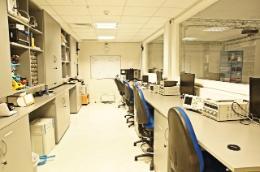Virtual Tour of York Robotics Laboratory
The Arena
The robot lab feautures a 80m2 arena space in which experiments of ground-based and air-based robots take place. The arena is approximately 5.5m high to provide the room for experiments with flying drones; we mostly use Parrot drones from the AR-Drone and Bebop Drone families.
Classroom
At the front of the lab is our new classroom area, which looks out onto the main arena. This area contains ten dual-boot workstations, bench equipment and components for students and researchers to use during laboratory session, project work or for other work. We also have a large display and a whiteboat the end of the room.
The Workshop

Adjoining the arena is a workshop area, equipped with a number of workstations and bench equipment for working with the robots. A comprehensive assortment of tools and spare parts ensures that we can keep the robots running in the lab.
The Robots
We use a number of different robots for research and teaching. Check out some of the videos below to see some of our robots in action.
Swarming Robots
A lot of our research focusses on biological inspiration towards robotic systems, and we are particularly interested in swarms of robots. We use three types of small swarming robots: the e-puck robot, developed at EPFL, the new Psi-Swarm robots and the older Pi-Swarm robots, developed here at YRL. These robots are used on a number of research projects, and also by post-graduates on the MSc Autonomous Robotics Engineering course and by undergraduates as part of their final-year research projects in the Electronics and Computer Science departments.
This video is of a final-year undergraduate project by a student in the the Electronics department, showing pattern-formation in the e-puck robots. Information about each robots position was determined using our infra-red tracking system, allowing messages to be sent to each robot guiding them where to go.
The video belows shows a group of Pi Swarm robots, developed at YRL, as part of an interactive swarm which reacts to environmental conditions. Read more about this project here.
Humanoid Robots
Humanoid robots use servos and motors to recreate the limbs of a human. In the robot lab we have a Nao robot, developed by Aldeberan Robotics, and a number of Robotis Bioloid robots. The Nao has a wide array of cameras and other sensors, and can detect speech and speak back. In the video below you can see the Nao robot in action, and the Bioloid robots dancing to the Psy hit Gangnam Style...
Flying Robots
The robot lab arena was designed with extra height to allow experiments with flying platforms. We currently use a fleet of a dozen Parrot AR Drone robots. We also have access to large hexcopter aerial platforms which can be used to carry a heavier payload outdoors.
The video below shows one of the final runs for the MSc in Autonomous Robotics Engineering group project. In this project, the students were asked to locate an infrared beacon, located somewhere in the laboratory, using a ground-based robot. This required them to avoid a number of obstacles placed on the floor and perform a mapping of the area. This robot was then to recruit one of the AR Drone platforms, which was to hover above the beacon. Both robots were then to return to the home area, avoiding any obstacles in their way.
Other Robots
We have a number of other robots that are used on various research projects. These include two large Jaguar platforms, developed by Dr. Robot, which are fast off-road platforms capable of climbing steps and falling 150cm onto concrete without damage.
We have researched walking gates in hexapods using artficial bio-chemical networks.
We are involved in the CoCoRo project, which investigates underwater swarm robotics using two custom-built platforms, Jeff and Lily.
As an introduction to robotics, sensors and actuators, we use the Lego Mindstorms platform.
The Symbrion (Symbiotic evolutionary robot organisms) project was a large EU project that aimed to investigating the principles of how large swarms of robots can evolve and adapt together into different organisms based on bio-inspired approaches. Three different types of robot were developed with a unique docking mechanism, the allowed individuals to combine to form larger three-dimensional organisms. In the video below, an overview of some of work carried out at York Robotics Laboratory in conjuction with Bristol Robotics Laboratory on the Symbrion project, looking a self-assembly, macro-locomotion, self-repair and self-reconfiguration of the modular robots, can be seen.